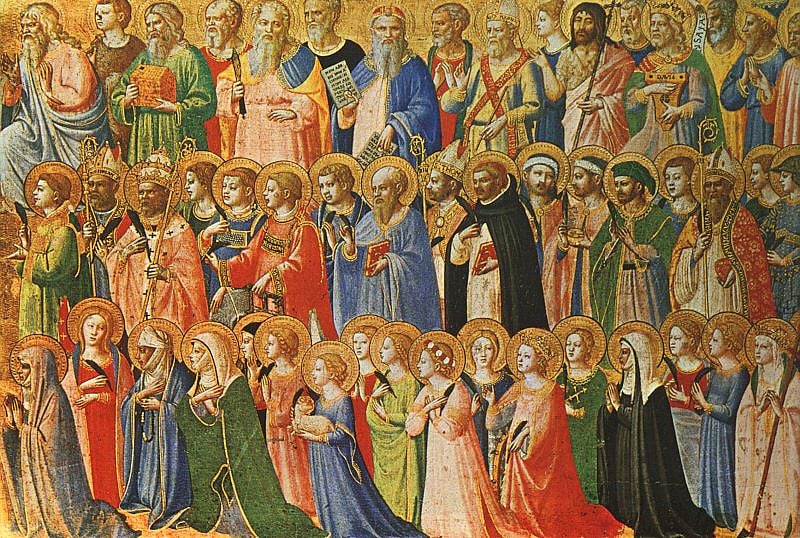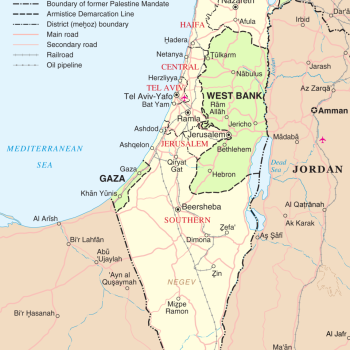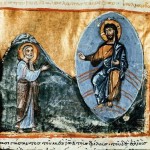
There are so many ways to go this week! There is a set of lectionary texts for the 23rd Sunday after Pentecost, but then there is also another set of texts for All Saints Day. And then, of course, there is Reformation Day, which many Protestant churches celebrate. There are too many texts in play to account for here, so you’re on your own for some of them. But I’ve chosen the most interesting–and pertinent–ones to look at here.
Ruth 1:1-18 (ordinary time text), Deuteronomy 6:1-9 (ordinary time text), Wisdom of Solomon 3:1-9 (All Saints Day text), Isaiah 25:1-10 (All Saints Day text), Jeremiah 31:31-34 (Reformation Day text)
What It’s About: All of these are texts that, in some way, look back to the biblical tradition for warrant for current practices. The Ruth and Deuteronomy are not specifically aimed at the All Saints Day liturgy, but they nevertheless evoke a sense of family and history. The Wisdom and Isaiah texts are chosen to provide a way to talk about continuity over time, and the way we relate to God and to each other even across the boundary of death. And the Jeremiah text is chosen to give credence to the idea of God doing a new thing–in this case, the Protestant Reformation. All of these texts are lifted out of context, of course, like all texts are always to one degree or another. But they can all provide powerful ways to think about the present on a day when the past is so fully in view.
What It’s Really About: These texts all had a life before Christians started using them for All Saints Day, Reformation Day, or just plain old Sunday worship. They are all about something else, and that’s important to keep in mind. They are not texts about these special days on the Christian calendar, but it is in the interpretation that we can see that kind of meaning. The Wisdom text, for example, is a moving ode to the way God thinks of and treats God’s faithful people, and so we can read that text as a way of talking about the faithful people we know about–especially those who have died. The Jeremiah text is all about God’s ongoing creative work in the world. More on that in a moment. Ruth and Deuteronomy, meanwhile, are about faithfulness and continuity, both themes that are easily adapted to either All Saints or Reformation Day celebrations. Ruth was faithful in ways she did not have to be, and that faithfulness bore fruit generations later in her contribution to the ancestry of Jesus (see Matthew’s genealogy). And the Deuteronomy passage is one of the most famous passages in the bible, and one of the most critical ones for Jews, who see in it the Shema, the statement of God’s oneness, the most essential summation of faith.
What It’s Not About: These texts cannot be about God’s favor for one group of people over another. They won’t make sense if you interpret them that way. What I mean is this: lots of different groups of people have read these in lots of different ways over the years, and there is nothing to say that one reading is true and the others not. Protestants read the Jeremiah text as an approbation of the Reformation, but that is a double-edged sword. The Jeremiah text was written centuries (millennia) before the Reformation, and it described an entirely different instance of God’s ongoing work. And now, in the twilight days of some Protestant communities, the Jeremiah text might well be used to talk about whatever is coming next–Emergence Christianity, or something else entirely. The point is this: which is ultimate, God’s ongoing work, or God’s ongoing work as expressed in my community? God’s work is the point, and it will be expressed in different communities, but it is important to remember that others have seen God’s work in these texts too, and that for those who believe in God, what is primary is that God is still at work in the world. Our own experiences of that, as institutionalized in churches and denominations, are secondary.
Maybe You Should Think About: What do we mean when we evoke the past? All Saints Day and Reformation Day are both ways to talk about the present and the future by talking about the past. We point to those who have come before us as a way of talking about who we are, and who we want to be. This is in some ways the story of Ruth; she knew that in order to be who she needed to be, she needed to maintain connection to her past–her husband’s family. In Jeremiah, God is doing a new thing, but it’s the same God. The Wisdom text is all about God’s faithfulness, not really about ours. As you plan your All Saints Day or Reformation Day (or both), think about what we are doing when we evoke the past. What does it say about us? How do we argue with it? How do we turn it to our own purposes?
Hebrews 9:11-15 (ordinary time text), Revelation 21:1-6 (All Saints Day text), Romans 3:19-28 (Reformation Day text)
What It’s About: This is the part of the lectionary often referred to as “the epistle,” but of these texts, only Romans is an epistle. Hebrews is probably a sermon, composed and delivered in Rome in the last first century, and the lectionary has been working through it for several weeks now. Revelation is, of course, the New Testament’s only example of a full-blown apocalypse, and while it contains some epistolary material (the letters to the churches of Asia Minor), it’s really a different genre altogether, especially in chapter 21. Romans is, of course, the epistle par excellence, and Paul’s greatest expression of theology in the New Testament–and one of the major sites of theological disputation for Christians ever since he wrote it.
What It’s Really About: Hebrews is all about verse 15, where the work of the last several weeks of Hebrews texts is really paying off. Hebrews is, as I’ve said in previous weeks, really trying to work out in what sense Jesus is salvific. How does Jesus save? This is from a time before Nicaea, before the creeds, before any systematic working-out of Christian doctrine of salvation. In Hebrews, the author is casting about for ways to think about how Jesus saves, and he (we presume it was a he, although we don’t know for sure) lands on Jesus as high priest. In this role as high priest, the author says, Jesus mediates a new covenant–although I don’t think we can assume that the author meant the same thing by “new covenant” that later Christians, like us, have meant. The Revelation text, meanwhile, is a really beautiful vision of the world made new. One of the things that has always struck me about this text is that it is a new heaven and a new earth that are revealed. There is no sitting-on-clouds nonsense; no ethereal realm awash with light and angels to bring you new drinks 24/7, as we sometimes imagine. This is everything made new again. Jerusalem is made new again–I presume with all the stuff that makes it Jerusalem, like markets, and streets, and houses, and people, and sewers, and restaurants, and all the rest. This is not an obliteration, as Christian apocalyptic theology has usually had it, but this is a renewal–a vision of things made right.
What It’s Not About: This Romans text is one of the most disputed passages of the entire New Testament, and so it’s probably in the Reformation Day lectionary because Protestants assume that it argues for their own position. I won’t get into it too much here, but suffice it to say that bible scholars have made a dramatic turn over the last generation or so, and are more and more seeing Paul’s message in his letters in a way that doesn’t really comport with the way the Reformation thinkers interpreted him. In the Reformation, Paul was made out to be an anti-law, anti-works, pro-faith Christian who turned his back on the legalism of Judaism for the freedom and grace of Christianity. And, of course, those views of Paul about Judaism came to stand in for Christian views about the Roman Catholic church. Most bible scholars reject that view now, in favor of what is called the New Perspective on Paul, which reads his letters with a new eye to the meaning of key words, to Paul’s continued insistence on the efficacy of Judaism, and to Paul’s own biography. There are several good books on the subject, including one from my friend and colleague Pamela Eisenbaum, titled Paul Was Not A Christian. Check it out and see the various ways in which the Reformation way of reading this Romans text is pretty misguided. And I say that as a Protestant.
Maybe You Should Think About: If the texts from the Hebrew Bible were all about the past, then these are really about the future. What does our tradition say, and what does it do? What has God promised us, and how can we claim that promise? Where are things going–to obliteration, or to renewal? And what role does Jesus play in all of it?
Mark 12:28-34 (ordinary time text), John 11:32-44 (All Saints Day text), John 8:31-36 (Reformation Day text)
What It’s About: The Mark text is about that Deuteronomy text above, which is why they are paired together in the lectionary. Jesus is citing and reinterpreting this saying in new kinds of ways. The John 11 is the second part of the story of the raising of Lazarus, and it serves as an affirmation, on All Saints Day, of the general resurrection of the dead. The John 8 text is about belief, and belief making a permanent home in God’s family for those who profess it–a classic Reformation doctrine.
What It’s Really About: More than the other texts above, these passages seem to be plucked out of their contexts to serve duty in today’s readings. They are abstracted from their broader passages in such a way that loses a bit of their meaning, but zeroes in on a certain kind of meaning. They were chosen, we can guess, because they talk about resurrection and belief, but to me these passages are less useful than the ones above, because they are broken apart from their contexts.
What It’s Not About: One of the things that the Lazarus text does is to make All Saints Day all about resurrection. And, for me, that is not what All Saints Day is all about. All Saints Day, it seems to me, is an occasion to acknowledge and remember all those who came before us in life and in faith. It is a way to make them alive–in a sense–through memory. The story of Lazarus is related to that, of course, but it is a much more physical way of thinking about the dead–as potentially alive again. Likewise, the John 8 text makes Reformation Day all about belief. (The Romans text does that a little bit too). It puts the emphasis on the act of intellectual assent to a proposition–Jesus is Lord–and not on action. That is the Reformation emphasis, of course, but I think, after 500 years, that we might do well to take a step back and ask whether that is really what we want to claim. Part of that New Perspective on Paul that I mentioned above has been to question whether belief as intellectual assent is what Paul had in mind, or whether maybe something more like faithfulness–ours and Jesus’–could be the base of our religion.
Maybe You Should Think About: There are lots and lots of texts to work with this week. And there are several different ways to go. Think about how the past talks to the future, and how the future holds the present hostage. Think about how these texts are all speaking to that in some way. And think about how best to serve your congregation on this important day.















